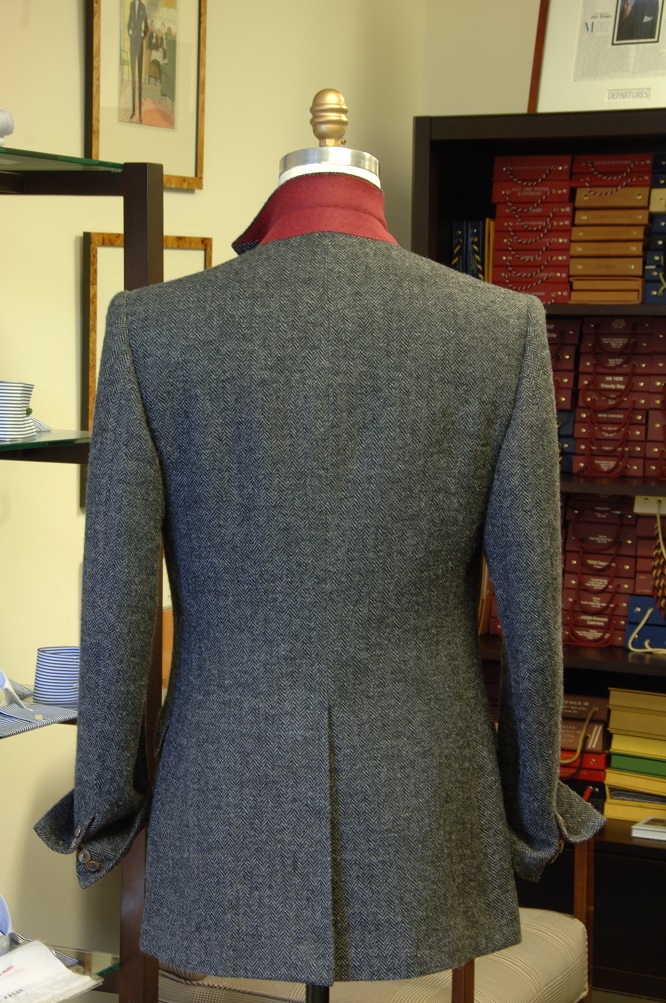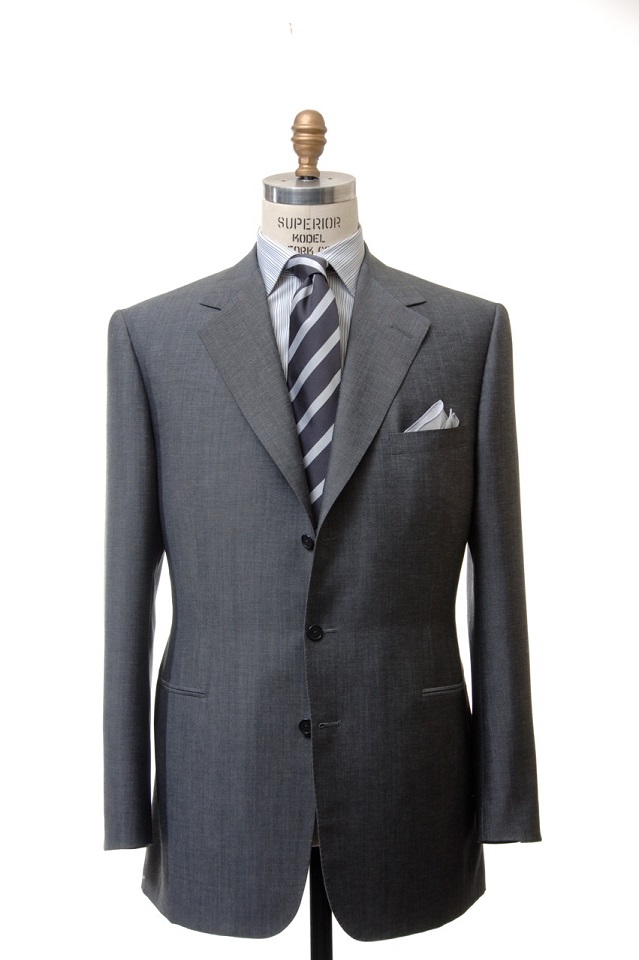Jon Green is a celebrated New York-based bespoke clothier well-known to readers of Forbes, The Financial Times, and American Express’ ‘Departures’ magazine. His loyal and exclusive customers who typically operate in a rarefied air of luxury and quality, can demand, and receive, the best.
Jon, a true gentleman and passionate craftsman, is a good friend of OTC. He possesses the unique ability to make both a globe-hopping corporate executive and clothing neophyte feel equally respected and appreciated. At his core, Jon is an educator and historian of all that is ‘bespoke.’
In this guest column, he provides a thoughtful and educational retort to last year’s New York Times article on bespoke tailoring.
The article, “What’s a $4000 Suit Worth?” appeared in the Sunday New York Times Magazine of September 4, 2012. Written by Adam Davidson, an American journalist focusing on business and economic issues for National Public Radio, he also writes the “It’s the Economy” column in the New York Times Magazine.
As a bespoke clothier on Madison Avenue for over 20 years, I read Davidson’s article with great interest.
For the article Mr. Davidson interviewed Peter Frew, a 33-year-old Jamaican born bespoke tailor who apprenticed in Savile Row, London. Mr. Frew, who now works out of his apartment in Queens, makes bespoke suits for clients entirely by hand and by himself. This endeavor takes him 75 hours for each suit, or about 2 suits per month.
Initially, Davidson’s contact with bespoke craftsmanship prompted his acknowledgement of what a skillful tailor can achieve with shears, needle and thread, and his hands. But his excitement quickly faded after learning that in spite of charging $4000 for his suits, Frew made only about $50,000 a year.
“As I watched Frew work, it became glaringly obvious why he is not rich,” Davidson observed. “Like a 17th-century craftsman, he has no economy of scale,” a very powerful point for the author in this discussion. Davidson goes on to say that, “the odd riddle” of bespoke tailoring in our economy is why more people are not willing to pay for it.
One reader responding on-line put it this way, “Bespoke clothing is one of those things you either ‘get’ or you don’t!” That certainly has been my experience.
It is unreasonable to expect that those who find ‘acceptable’ preferable to ‘optimal’ would appreciate the psychic income of a bespoke suit. The lack of appreciation for quality in our culture is profound.
In either case, Davidson missed a great opportunity to enlighten his readers, and perhaps himself, about the value of “Bespoke” clothing.
 The craftsmanship required to make a bespoke suit has been passed down for centuries through years of training and apprenticeships with master tailors; artisanal craftsmanship develops over a lifetime.
The craftsmanship required to make a bespoke suit has been passed down for centuries through years of training and apprenticeships with master tailors; artisanal craftsmanship develops over a lifetime.
Conversely, ‘an economy of scale’ requires mass production; bespoke clothing cannot be mass-produced.
In today’s marketplace, luxury goods exist primarily as brands of the giant luxury goods conglomerates PPR (Pinault-Printemps-Redoute) whose brands include Gucci, Botega Veneta, Stella McCartney, et al, and LVMH (Louis Vuitton • Moët Hennessy) whose brands are Fendi, Pucci, Givenchy, Berluti, Bulgari, et al. These conglomerates buy artisanal businesses with good reputations and restructure them as profit centers by employing “economies of scale.”
Suzy Menkes, a British journalist and head fashion reporter and editor for the International Herald Tribune since 1988, reflects in her December 6, 2012, New York Times article, on the everlasting style and taste of Valentino Garavani’s retrospective in London’s Somerset House. In it she opines, “Is that alta moda era gone forever with the corporate luxury culture and the tsunami of fast fashion?”
It would be a sad irony indeed to have the money to buy whatever you desired only to have the choice of branded “merchandise” available in malls and airport shops all over the world.
Bespoke vs. Made-to-Measure clothing – Since the early twentieth century there has existed a grey area of garments between the poles of bespoke and ready-to-wear; for which the customer was measured and garments made to the closest standard size in a factory. The distinction made here is between bespoke, a paper pattern created specifically for a client, and made-to-measure, which alters an existing pattern to accommodate some changes for the customer.
Technological change makes this distinction more subtle since fittings are increasingly required for both bespoke and made-to-measure. However, a bespoke service requires an individually created and cut paper pattern kept on file for future orders. Today made-to-measure measurements are often stored too, on a computer.
 Hand-work, often cited as an exclusive benchmark of bespoke, is now increasingly found in limited amounts in made-to-measure garments. Machine-making plays a small part in the creation of most bespoke suits in the sewing of some straight seams for strength and smoothness. Comparison between the construction techniques of bespoke and those of made-to-measure must be experienced to be understood.
Hand-work, often cited as an exclusive benchmark of bespoke, is now increasingly found in limited amounts in made-to-measure garments. Machine-making plays a small part in the creation of most bespoke suits in the sewing of some straight seams for strength and smoothness. Comparison between the construction techniques of bespoke and those of made-to-measure must be experienced to be understood.
Like many others, Davidson lacks the above distinctions, which may explain why Martin Greenfield is identified in the ‘Slide Show’ accompanying Davidson’s article on-line as a “Bespoke Tailor.” Martin Greenfield is a manufacturer whose factory makes ready-made and made-to-measure suits for retailers, tailors, and customers, by the tens of thousands each year.
All of us differ on what we think is ‘worth it.’ Many men, rich or not, would not consider paying even $1000 for a suit. Not because they can’t, but because they don’t see the point.
But for the receptive, a bespoke suit is the perfect expression of artistry and function – an irreplaceable essential whose quality provides the satisfaction that an economy of scale can only promise.
People buy solutions; and to my mind, nothing meets the daily requirement of being well dressed as superbly as a bespoke suit.
Jon Green Bespoke
509 Madison Avenue
New York, NY 10022
Additional images of Jon Green’s bespoke craftsmanship:






Luxury Male grooming products for today’s modern men. Full range of selected male products ranging from Skincare, shaving, nail care, shaving brushes, shampoos, body shower, hair loss products, shaving creams, balms and more. Join our forum for in depth tips, news, latest happenings in the field of men care products and more.
Love the mult-colour paisley on the navy ground tie. Is that one of Jon’s or is it from one of the Italian makers?
Thanks Ted, I believe that is one of Jon’s ties. I’ll check with him and report back.
ゴローズ カスタム
Thanks for this piece Jon, you have really given a great insight into fitting bespoke suits- do you supply suits around the world if I have already been measured for a previous tailor made suit?